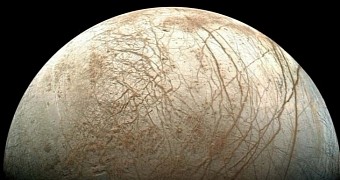Jupiter's moon Europa, which sits at a distance of about 628,300,000 kilometers (roughly 390,407,520 miles), is more like Earth than previously assumed. Thus, both these celestial bodies appear to experience plate tectonics.
In a recent paper in the journal Nature Geoscience, researchers explain that, according to evidence at hand, Europa's makeup includes several rather big ice plates. Rather than sitting in one place, these plates seem to be shuffling around.
Much like the rock plates covering the surface of our home planet, the ones on Jupiter's moon collide with one another every once in a while. Whenever this happens, Europa's appearance is more or less visibly altered, Nature explains.
So how was plate tectonics documented on Europa?
When it comes to our planet, keeping tabs on natural phenomena is not all that difficult. Figuring out what celestial bodies that sit millions of kilometers away from Earth are up to, on the other hand, can prove quite tricky.
In order to pin down the ice plates on Europa and document their movement, researchers Simon Kattenhorn and Louise Prockter analyzed images obtained with the help of NASA's Galileo spacecraft between 1995 and 2003. Their focus was on changes in the moon's appearance.
It was thus discovered that, during the time that NASA's spacecraft spent orbiting Europa, the moon lost part of its surface. Specifically, the researchers say that, after treating the ice plates as part of a puzzle and putting them back together, they found that a considerable chunk was missing.
As detailed in the journal Nature Geoscience, Simon Kattenhorn and Louise Prockter suspect that this ice plate vanished after being sucked into a buried ocean. The plate likely embarked on its journey to Europa's core after colliding with another one that got on top of it and pushed it downwards.
“We propose that Europa’s ice shell has a brittle, mobile, plate-like system above convecting warmer ice,” the researchers write. “Hence, Europa may be the only Solar System body other than Earth to exhibit a system of plate tectonics,” Simon Kattenhorn and Louise Prockter further explain.
The implications of this discovery
If these two brainiacs are right and Europa is in fact home to massive ice plates that keep moving around and forcing each other to go for a dive in the ocean lying right under them, this means that this moon is way more active than previously assumed.
Specifically, it could be that, as one ice plate gets pushed downwards by another, salts, minerals, and even teeny tiny microorganisms rise to the surface, aided by the ongoing commotion. This would mean that, much like Earth, Europa cycles compounds from the surface to the deep, and vice versa.
Simon Kattenhorn and Louise Prockter plan to continue studying this icy moon and hope to find further evidence of plate tectonics on it. Thus, the researchers want to look at several more images of Europa and pin down other subduction phenomena.

 14 DAY TRIAL //
14 DAY TRIAL //